
ROLAND LAKE CASE STUDY
1. Background
Roland Lake is a 30-acre recreational lake in Virginia. In 2017 the lake was suffering from a longterm accumulation of mucky, nutrient-rich organic sediment that had allowed excessive dense invasive weeds to grow in all areas of the lake 10 feet deep or less making it virtually impossible to launch a boat or swim out into the lake for several years.
Three years earlier, a considerable sum had been spent on dredging the lake to get rid of the organic sediment that was facilitating the excessive proliferation of invasive hydrilla, milfoil and pond weed. Despite, or because of this, the weeds and algae were blooming stronger than ever.
After completing a detailed bathymetric survey of the lake in October 2017, a bio-engineered solution design incorporating a RADOR system and bioaugmentation treatment program was presented and accepted.
The solution was commissioned by the Clean-Flo team in April 2018, and the invasive weeds and algae were improved in 2018 and the lake could once again be used for swimming and other recreational activities.
The annual bathymetric scan conducted in October 2022 showed that the lake’s depth continued to improve, allowing a detailed analysis and quantification of the reduction in aquatic weed biovolume and sediment over the five years during the remediation project. Worth noting, Roland Lake is still a customer today.
2. Nutrient Recycling
2.1 Scientific Principles
Nutrient recycling occurs when there is a positive feedback loop of sediment accumulation which promotes more invasive weeds, leading to more sediment. When mother nature cannot keep up with sediment digestion and the sediment accumulates, waterbodies lose volume and depth and eventually the lake dies.
2.2 Analysis of Depth Profile & Vegetative Coverage
Aquatic vegetation, which consisted overwhelmingly of invasive weeds such as milfoil, hydrilla and pond weed, occupied 32.7% of the volume of the lake. The vegetation “heat map” shows that only the area of the lake 10 feet or deeper is free of weeds (blue). Areas that are green, yellow, orange, and red show increasing density of vegetative biovolume.
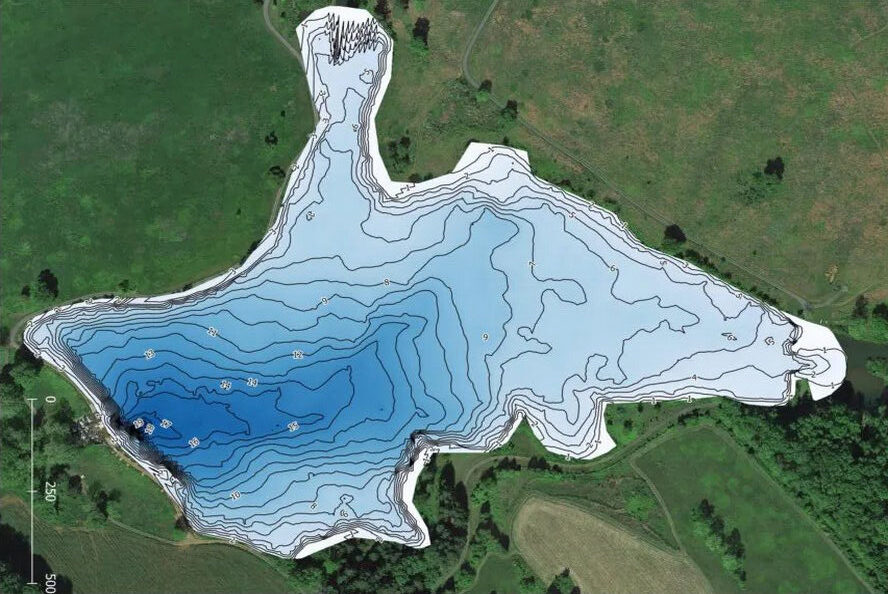
Bathymetry-Analysis
Contour Map showing depth
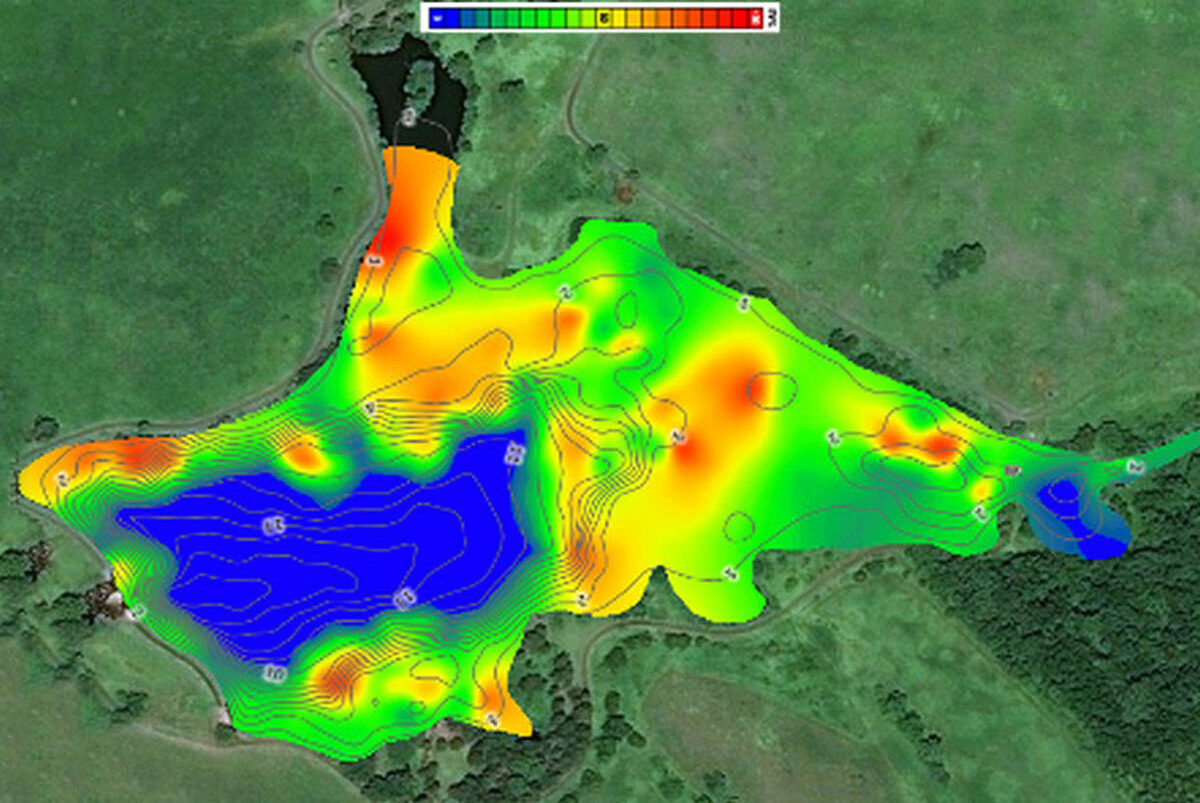
bathymetric_lake_profile_before-h-e1719297851197
Aquatic Vegetation Map showing coverage
The Clean-Flo / SIS.BIO solution was commissioned in April 2018 and incorporated 10 RADOR units and an intensive annual bioaugmentation treatment program.
Bioaugmentation comprises a combination of digestive enzymes and micronutrient supplements to stimulate the regeneration of the food web responsible for nutrient clearance in aquatic ecosystems.
3. Sediment Reduction
3.1 Scientific Principles
We deploy Bio-Dredging to remove muck & sediment. There are three key principles to understand how Bio-Dredging is achieved.
1. By creating aerobic conditions and providing enzymes to actively digest the sediment, the rate of digestion of sediment is increased so there is a net reduction in sediment.
2. By suppressing and controlling the rate of nutrient recycling by oxygenation, the amount of phytoplankton biomass produced can be limited to a level at which the food web can consume more of it before it dies off, so there is less dead biomass sinking back into the sediment.
3. By maintaining an aerobic benthic margin, benthic zooplankton can function across the whole lake bottom, thus increasing the nutrient clearance capacity of the food web.
So the principle that full oxygenation must be ensured for remediation applies again.
3.2 Digesting Muck & Sediment Increases Volume and Eliminates Weeds
The whole of the north end of the lake was around 2 feet deep in 2017 and the 5 feet and 8 feet contour were close together around the deep basin at the southern end of the lake (see Figure 3).
The map to the right shows the situation in October 2022. All the shallower parts of the lake are at least 5 feet deep. In fact, the area encompassed by the 5 feet contour has more than doubled from 10.3 acres to 22.6 acres.
Similarly, the area encompassed by the 8 feet contour has increased from 8.5 acres to 12.4 acres.
The increase in the volume of well oxygenated water capable of sustaining the animal life in the food web that is responsible for nutrient clearance is a critical factor in the holistic remediation of the lake and is reflected in the reports of improved health and numbers of fish in the lake.
Without re-establishing this nutrient clearance functionality, continued sediment nutrient recycling would have resulted in the production of excessive algae blooms and a transition to toxic cyanobacteria HABs over time.
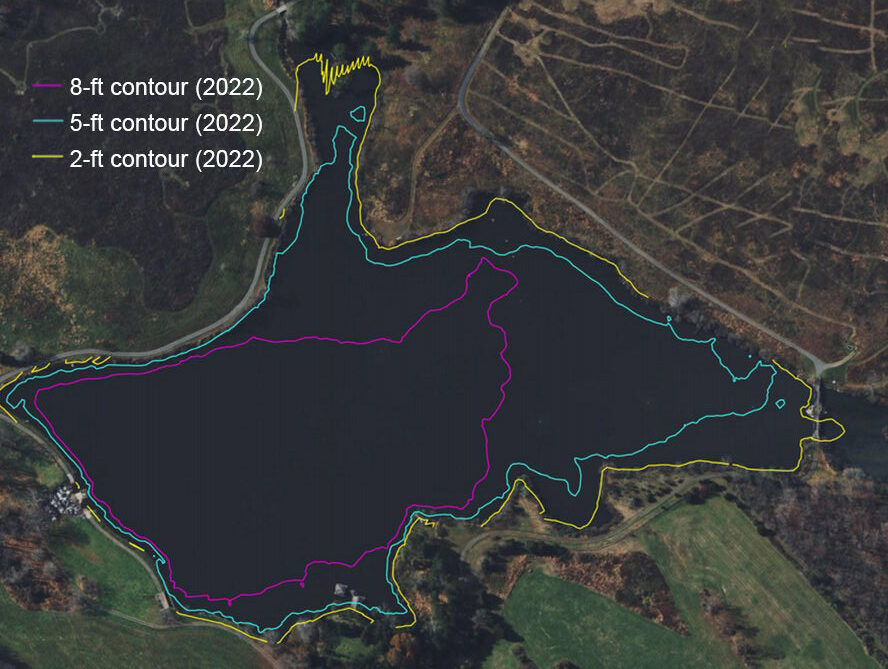
Roland-lake-contour-figure-4
2017 Contour Map showing a very shallow north end
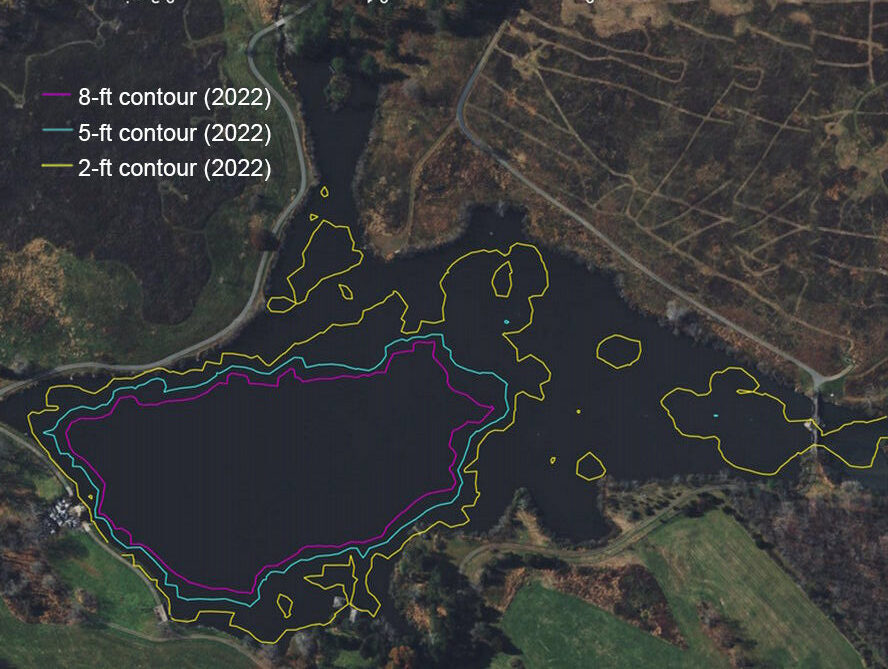
Roland-lake-contour-figure-3
2022 Contour Map showing extensive expansion of the 5 ft contour line in blue
The following contour maps and side scan depth profiles further show the increase in depth and the sediment that has been removed.
Using sophisticated software, it is possible to draw a transect down the lake as indicated by the red lines below and rotate the view by 90 degrees to examine the lake in profile.
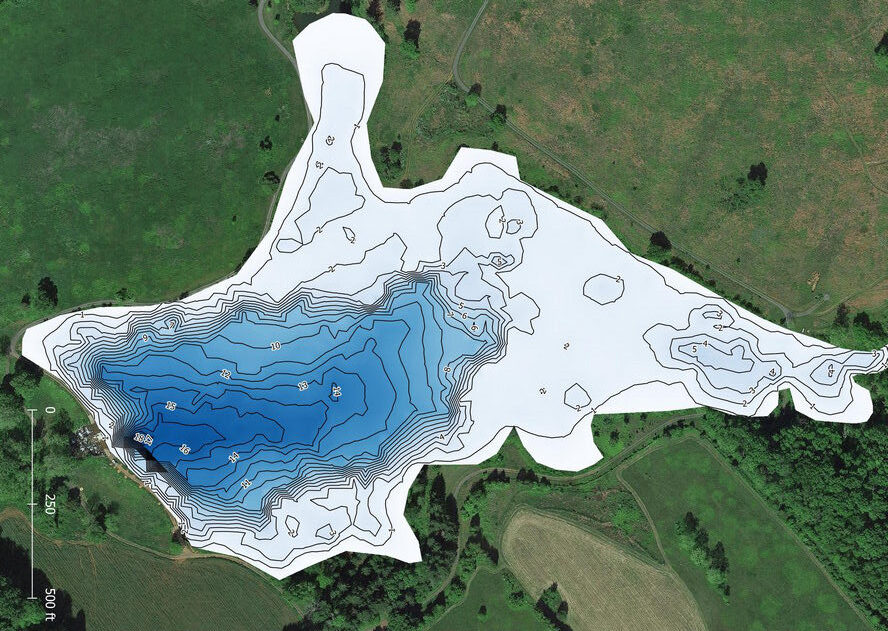
Roland-lake-figure-5
2017 Contour Map showing most of the lake was extremely shallow
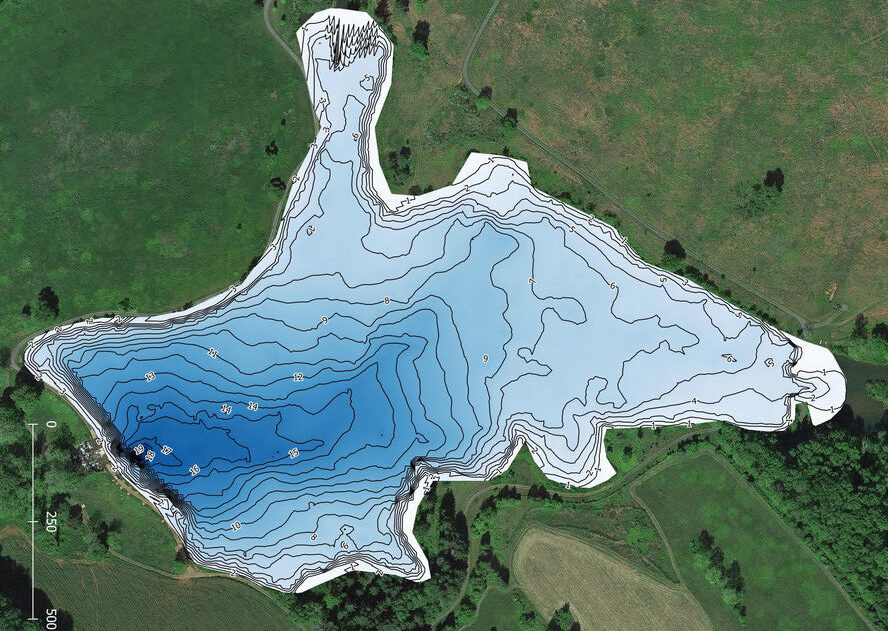
Roland-lake-figure-6
2022 Contour Map showing extensive expansion of the depth throughout the lake
The purple line shows the bottom profile of the lake in October 2017 and the black line shows the bottom profile in October 2022. This provides another way to visualize the impact and effect of the remediation program in digesting and eliminating accumulated mucky organic sediment that is the root cause and driver of invasive weed growth.
Roland Lake Bottom Profile
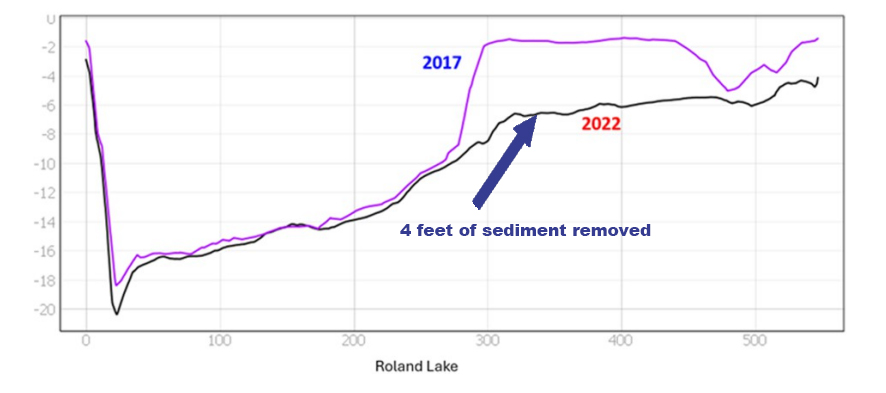
Roland-Lake-Bottom-Profile
The gap between the 2017 line and 2022 line shows the volume of sediment removed
The average depth of the lake (volume divided by surface area) has increased from 5.1 feet to 7.9 feet. The maximum depth has increased from 17 feet to 20.5 feet.
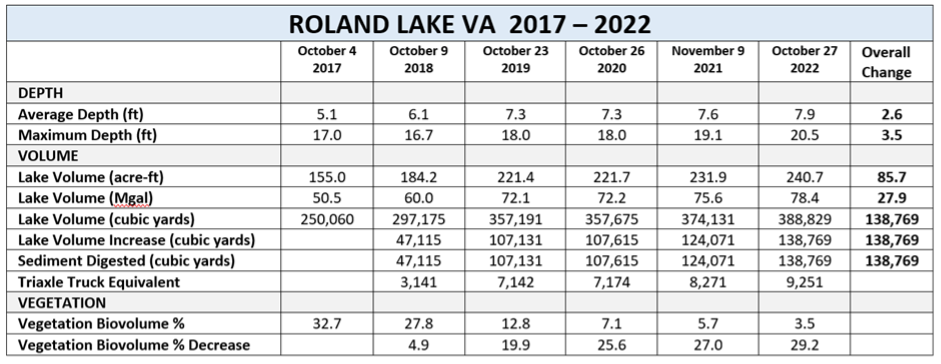
The volume of water in the lake has increased from 155 acre-feet (50.5 million gallons) to 240.7 acre-feet (78.4 million gallons), an increase of 55%. This is an increase of 138,769 cubic yards. This has been achieved by digesting 138,769 cubic yards of organic sediment that was sustaining invasive weed growth in the lake.
As can be seen in the profile view below, most of this organic sediment was in shallow areas of the lake. As described previously, most of the lake that was around two feet deep in 2017, is now 5 feet deep or more.
4. Summary
SIS.BIO’s ONE Biotechnology has been delivering the recommendations of the 2022 GAO Report for many years. It is based on directly addressing root causes rather than second order symptoms.
That means that the parameters we monitor differ from convention. Rather than monitoring general water quality parameters, we specifically focus on measurement of:
- Oxygenation
- Phycological profiles (phytoplankton taxa and biovolume)
- Bathymetric data to monitor sediment reduction by Bio-Dredging.
This protocol not only speaks directly and specifically to the root causes of eutrophication and HABs, but it also measures parameters that we can influence and control and provides relevant input for adaptive management, program optimization, and performance measurement towards the achievement of specific remediation objectives.
ONE Biotechnology does not provide the instant gratification that symptomatic treatments such as herbicides and algaecides do. But it is wise investment that delivers sustainable, on-going remediation and restoration of natural biological function while delivering to the GAO’s recommendations.
Download the Lake Management ACTION Plan E-Book
Ready to explore how oxygenation can transform your lake? Download Clean-Flo’s Lake Management ACTION Plan E-Book to learn more about our innovative solutions, real-world results, and how we can help restore and protect your lake.
